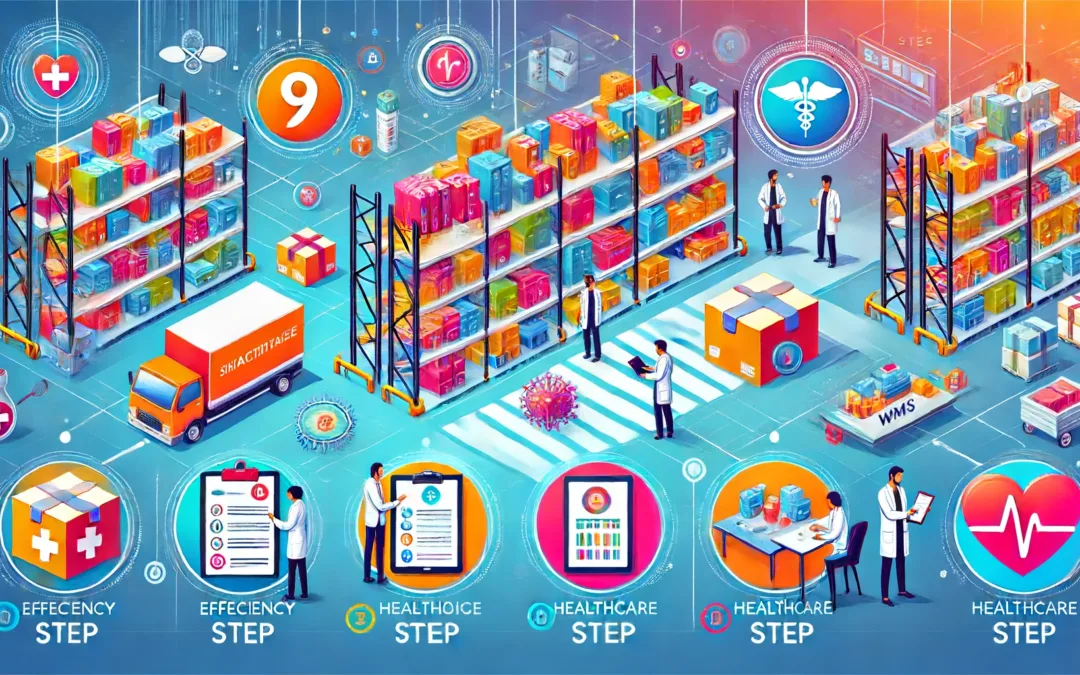Revolutionize your Supply Chain Management
When it comes to sectors where supply chain strength is non-negotiable, two industries immediately stand out: military and healthcare.
In healthcare, supply chains do not tolerate errors. They are like high-risk juggling acts, filled with complexities ranging from managing sensitive inventories to complying with strict regulations. It's like walking a tightrope while balancing a tower of pill bottles!
Healthcare supply chains demand absolute precision and efficiency. A poorly managed order or delayed delivery can have serious consequences for patient care. This underscores one of the most important aspects of a strong healthcare supply chain: having the WMS/WMS appropriate.
Contents
- Warehouse Management System in the Health Supply Chain
- Challenges of Implementing a WMS / EMS in Health
- Importance of WMS / SGA in Health Supply Chain Management
- Step-by-Step Guide to Implementing a WMS/EMS in the Healthcare Supply Chain
- Do you need help selecting or implementing a WMS / EMS for your healthcare organization?
Warehouse Management System in the Health Supply Chain
A Warehouse Management System (WMS/WMS) is a software platform designed to manage and optimize various aspects of warehouse operations within the healthcare supply chain. It helps healthcare providers, pharmaceutical companies, and other related organizations efficiently manage inventory, track product movement, and streamline processes.
Main Functions of a WMS / WMS in Health:
- Inventory Control
- Order Processing
- Tracking and Traceability
- Optimization of processes
- Regulatory compliance
- Data Analysis and Reports
Implement a WMS/WMS can significantly improve inventory management, optimize order processing, ensure regulatory compliance, improve warehouse operations, and ultimately improve patient care through a more reliable supply chain.
Challenges of Implementing a WMS/WMS In the health
Implement a WMS/WMS in health presents unique challenges, such as:
- Regulatory compliance: Adhere to strict regulations from agencies such as the FDA, DEA and HIPAA.
- Unique Inventory Management: Handle specialized items such as controlled substances and medical devices with specific storage requirements.
- Traceability and Serialization: Ensure accurate tracking to prevent counterfeiting and ensure patient safety.
- Temperature and Environment Control: Maintain adequate conditions for products such as vaccines and biological samples.
- Due Date Management: Track expiration dates and ensure proper inventory rotation.
- Order Accuracy and Patient Safety: Minimize medication errors through accurate order fulfillment.
- High Volume and Turnover: Manage rapid inventory turnover efficiently.
- Interdepartmental Coordination and Workflow Optimization: Coordinate between various departments such as pharmacy and laboratories.
- Training and Competence of Personnel: Train a diverse workforce on new systems.
- Change management: Overcome resistance to new processes and obtain support from stakeholders.
Importance of WMS in Health Supply Chain Management
Implementing a WMS offers several benefits:
- Improvement in Inventory Management: Provides real-time visibility and control over inventory levels, reducing shortages and waste.
- Efficient Operations: Automates order processing, reducing errors and increasing efficiency.
- Better Traceability and Compliance: Ensures compliance with regulatory requirements and accurate tracking.
- Optimization of processes: Improves warehouse processes and space utilization, increasing productivity.
- Regulatory compliance: Helps maintain regulatory compliance through proper tracking and documentation.
- Customer Privacy and Data Protection: Ensures secure handling of sensitive patient data.
- Data-Based Decision Making: Enables informed decisions through data analysis.
Step by Step Guide to Implement a WMS/WMS in the Health Supply Chain
- Assess Needs and Challenges: Identify current inventory management and order processing issues.
- Set Goals and Objectives: Define clear implementation objectives.
- Select the Right WMS/WMS Solution: Choose a system that meets specific needs and integrates well with existing systems.
- Ensure System Integration: Integrate the WMS/WMS with other systems such as EMR and ERP.
- Develop a Complete Implementation Plan: Plan system complexity, training and testing phases.
- Establish a Project Team and Assign Roles: Include stakeholders from various departments.
- Create a Realistic Schedule and Budget: Include all implementation costs and allow time for testing.
- Provide Training and Support: Ensure complete training for staff.
- Monitor Progress and Continuous Improvement: Regularly evaluate KPIs and optimize processes.
Do you need help selecting or implementing a WMS/WMS for your Health Organization?
If you have difficulty choosing the WMS/WMS appropriate or need help with implementation, getting professional help can ensure that you achieve the benefits of a well-executed implementation, leading to greater efficiency, accuracy, and patient care.
For more information about implementing a WMS/WMS in health, you can contact experts in the sector or consult detailed guides and resources provided by healthcare providers. WMS/WMS.
Discover how our advanced solutions can transform the efficiency and accuracy of your inventory management and logistics operations.
Challenges in Inventory Management
Rapid inventory turnover and interdepartmental coordination are essential to maintaining efficiency in the healthcare supply chain. Staff training and change management are crucial to the adoption of new systems. A WMS can be the key to overcoming these challenges and improving supply chain management.
Efficient Coordination
Coordinating between departments such as pharmacy and laboratories is vital to workflow. A WMS facilitates this coordination, ensuring that all departments work in synergy.
Training and Change Management
Training a diverse workforce and overcoming resistance to new processes are constant challenges. A well-implemented WMS can simplify this process, providing necessary tools and support.
Benefits of Implementing a WMS

Improvement in Inventory Management
Efficient Operations

Assess Needs and Challenges
Identify current issues in inventory management and order processing to determine areas needing improvement.
Set Goals and Objectives
Define clear and measurable objectives for WMS implementation, aligned with the specific needs of your organization.
Select the Right WMS/WMS Solution
Choose a WMS system that suits your requirements and can be easily integrated with existing systems such as EMR and ERP.

Do you need help selecting or implementing a WMS / SGA?
If you have difficulty choosing the WMS/WMS appropriate or need help with implementation, getting professional help can ensure that you achieve the benefits of a well-executed implementation, leading to greater efficiency, accuracy, and patient care.


